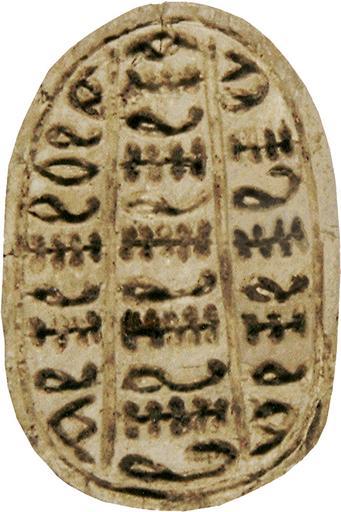MAKE A MEME
View Large Image

| View Original: | Canaanite_-_Scarab_with_Three_Columns_of_Pseudo-hieroglyphs_-_Walters_4219_-_Bottom_(2).jpg (600x900) | |||
| Download: | Original | Medium | Small | Thumb |
| Courtesy of: | commons.wikimedia.org | More Like This | ||
| Keywords: Canaanite - Scarab with Three Columns of Pseudo-hieroglyphs - Walters 4219 - Bottom (2).jpg The ancient Egyptians believed that the dung beetle the Scarabaeus sacer was one of the manifestations of the sun god Representations of these beetles were used as amulets and for ritual or administrative purposes This scarab has a special motif on the bottom which is known as a-n-r-combination because it consists of the sound-signs for 'ayn n and r The signs are arranged in three columns combined with lotus blossoms at the beginnings and ends; the columns are framed by an oval line The bottom design is deeply incised and the shape of the signs typical for the Second Intermediate Period n with a horizontal line crossed by short vertical lines c with a curved line and an oval lop at the end The highest point of the back is the elytron wing cases ; two side-notches at shoulder height define the partition between pronotum dorsal plate of the prothorax and elytron The head is trapezoidal and the clypeus has four frontal serrations and a central base notch The design of the back is simple the carved side-notches short and not totally aligned The proportions are unbalanced and the pronotum is short in comparison to the head section and the elytron The raised extremities have natural form and vertical hatch lines; the background between the legs is hollowed out The base is long-oval and the head part smaller than the rear part The scarab is longitudinally pierced was originally mounted or threaded and served as an amulet Probably it should grant magical and/or divine support a-n-r-pattern and regeneration lotus It is not possible to determine the exact meaning of the a-n-r-pattern although several options such as a relation to the name of the god Re or to a magical formula have been discussed In this special case with the dominance of c and n it would make sense to consider a magical formula which should strengthen the recreative scarab and regenerative lotus function by repetition ca 1648 1539 BC Second Intermediate; MB IIB light beige steatite cm 9 1 5 2 1 accession number 42 19 5337 Henry Walters Baltimore 1911 mode of acquisition unknown Walters Art Museum Henry Walters Acquired by Henry Walters 1911 Inscription Three columns of pseudo-hieroglyphs in the so-called a-n-r-combination combination of the sound signs c n and r place of origin Palestine <gallery> File Canaanite - Scarab with Three Columns of Pseudo-hieroglyphs - Walters 4219 - Bottom jpg </gallery> Walters Art Museum license Ancient Near East art in the Walters Art Museum Canaanite art Media contributed by the Walters Art Museum needs category review Three-column layout | ||||